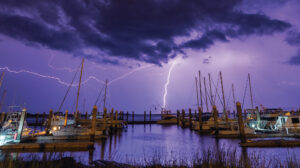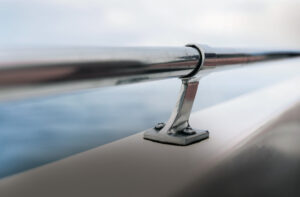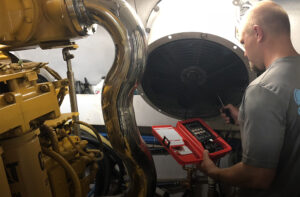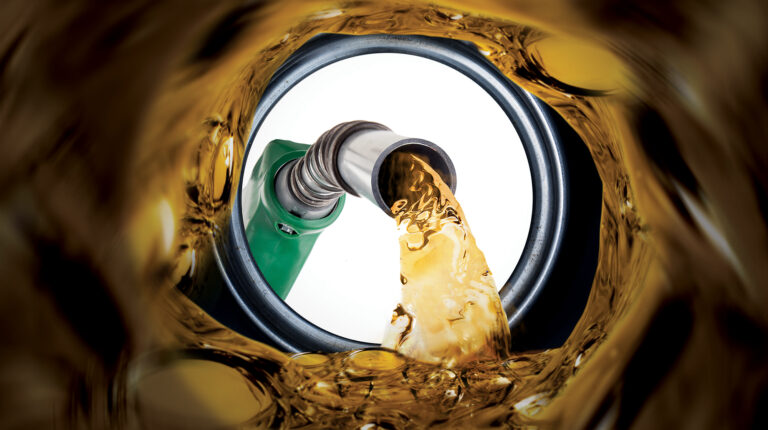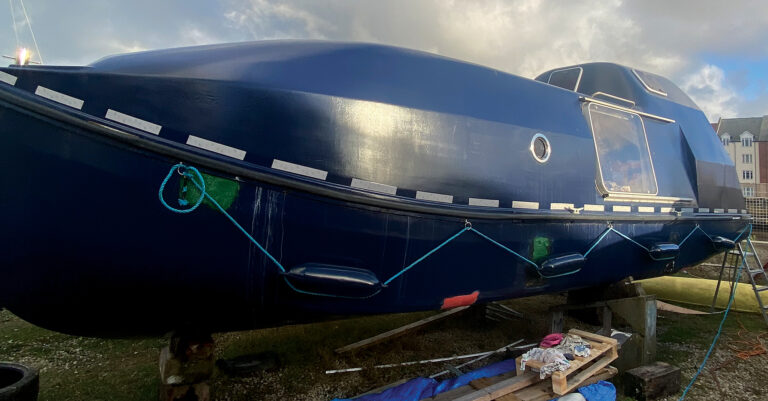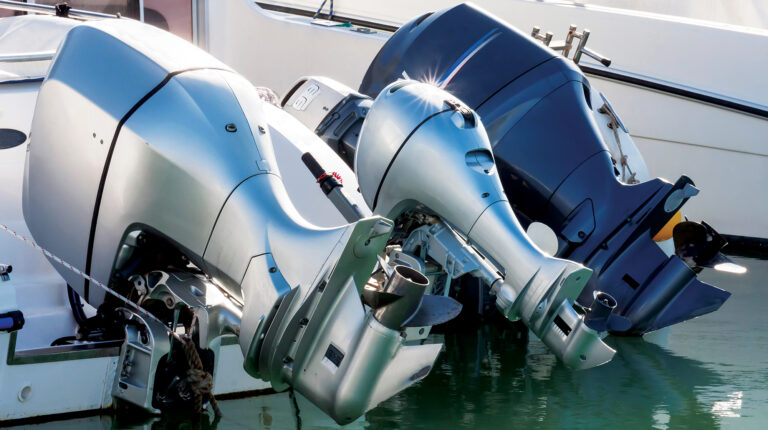Tend That Tender!
Davits and cranes need a little love, too. Ignore them and you might be left with your dinghy dangling.

Dinghies make boating a heckuva lot more fun. They ferry kids and their gear to the beach, take you ashore from a mooring, let you explore unfamiliar harbors without risk to props and rudders, and provide a means for getting off the mothership and blowing off steam now and then. But you need a convenient means for handling that dinghy. Who wants to macho-muscle the darn thing aboard and lash it upside-down on the foredeck, or unship and stow the outboard every time? Not me. I want a well-engineered, efficient, no-sweat system.
If you own a major-league or even midsize yacht, this is a no-brainer: You either have an integral slide-in, slide-out garage opening onto a spacious swim platform, or you stow the tender on the boat deck, alongside a crane that lifts, rotates, and lowers it at the touch of a button. Nice—but the rest of us have to find a place where the dinghy is out of the way, but still easy to launch and retrieve. Most boats make the decision for you: Transom, foredeck, extended flying bridge—there’s usually one place that works.
Boats with lofty bridges can carry the tender on the foredeck. This setup is popular with sportfishermen, who need to keep the transom clear for fighting fish, but underway the tender and crane live in a shower of salt spray, which can cause maintenance issues. Capt. Carl Gwinn can attest to this: When he took over a year-old Nordhavn 86 with two tenders on deck, a 16-foot RIB and a fancy Pease launch, Gwinn discovered there was already lots of salt damage to the crane. When the rotator “stopped rotating” and needed replacement, he said, it was already so corroded in place it took serious pressure from the boatyard hoist to break it free. (Cranes and their components are heavy, so repair usually demands help from the yard.) After installing the new rotator, Gwinn had a cover made for the crane to protect it. He disconnects the remote control and carries it in the pilothouse, out of spray’s way. And he always rinses the gear thoroughly.
The Old-Fashioned Way
Unlike the Nordhavn, many trawler and expedition yachts carry their tenders on a boat deck or extended flying bridge. Larger yachts mount a crane here, but smaller ones often make do with a mast and boom rigged with block and tackle and, often, manual winches. This old-fashioned gear is reliable, but from the flying bridge, it’s a long way to and from the water—especially from, if you’re retrieving the dinghy by hauling it up manually. Make the job easier by installing high-quality ball-bearing blocks; Harken is one of the brands I’d recommend.
Sometimes a pair of davits mounted on the transom is the only choice, and it’s not a bad one: A dink on davits doesn’t block the helmsman’s view, it’s sheltered from excessive spray, it’s not in the way when working on deck, and it’s easy to launch and retrieve. The only downside is, the dinghy can be damaged during docking adventures or by semicompetent marina neighbors. But inflatables are pretty rugged, and if you choose one that’s shorter than your boat’s transom beam, it’ll be somewhat protected. (See “Davits for the Rest of Us” at www.pmymag.com/davit.)
Keep Your Crane Cranking
Cranes need TLC, and the first rule is, rinse off the salt. Rick Thomas, founder and vice president of Nautical Structures, says, “Regular freshwater washdowns solve 80 percent of potential problems.” Stick the hose up inside the boom if possible to flush it out thoroughly. Be scrupulous in rinsing the sheave in the boom too: Dried salt and dirt will increase friction and reduce efficiency. Indeed, ensure all sheaves are turning freely.
At the start of the season, remove the sheaves and clean them thoroughly; replace any worn bushings—the bushings press into the aluminum sheaves, so you might need the yard’s help with this. Don’t lubricate: The bushings are self-lubricating, and adding oil will just make it easier for dirt and salt to get into the works.
Check for corrosion caused by galvanic action between the aluminum davit housing and any stainless steel fittings and components, says Thomas. (Stainless steel touching aluminum in an electrolyte—in this case, salt water or even damp salt—causes the aluminum to corrode.) The metals are isolated from each other when the crane is manufactured, but you can still get corrosion. Look for lifting paint. If you see some, scrape it off and touch it up. “Most people,” he adds, “have the davit completely repainted every five or six years.”
Thomas said competent owners can service cranes aboard yachts up to around 80 feet, but they should order an inspection at least every couple of years by a certified technician. Cranes aboard larger vessels, and those built under class rules, must have an annual inspection. Nautical Structures sells a parts kit for each crane with a spare cable, spare sheaves, replacement hydraulic valves, and other components that typically fail. Not all components are meant for owner replacement, but the company has a 24/7/365 help line, manned at all times by a staff member, that will steer you to a technician wherever you are cruising.
Make Friends with your Tech
That technician might be Carlos Castillo, owner of C-Systems & Services, Inc. in Ft. Lauderdale. Castillo and his team have serviced cranes, davits, passarelles, windlasses, bow thrusters, and other hydraulic systems aboard yachts all over the world. Indeed, Carl Gwinn called him to New England to repair the Nordhavn’s rotator, and Castillo is now on Gwinn’s speed dial.
Castillo says cranes, like people, benefit from exercise: Launch and retrieve your dinghy at least twice a week. You don’t have to drop it in the water, but lower it all the way to the surface so the crane gets a good workout. This keeps the seals soft, prevents the sheaves from binding up, gives you a chance to listen for unusual noises—for example, if the rotator makes a cracking sound, the bearing is worn, and soon the crane will start to bind. (Call a technician.) If the crane jumps or is sluggish, he says, try it without the tender; sometimes lack of use lets a little rust form on moving parts, or the seals get stiff, and a bit of use will often clear things up. When it’s not in use, stow the crane with the cylinders retracted so they won’t rust, and secure it properly.
Inspect stainless wire cables for kinks, fishhooks, and rust. “Cables last a long time, but follow the manufacturer’s instructions for replacement,” says Castillo. (It’s cheap insurance when you consider the consequence of a broken cable.) Although the multiple-sheave arrangement in most hydraulic cranes is very kind to the wire, he adds, some use a simple reel winch driven by an electric motor, which is less so. If you have a cable-on-reel crane, always maintain tension so the cable winds neatly on the reel and doesn’t get cross-wrapped, and check it frequently for damage.
Resources
www.peaseboatworks.com
www.harken.com
www.nautical-structures.com
www.csshydraulics.com
www.davit.com
Don’t Drop the Ball
No matter what sort of crane you have, keep an eye on the pressed sleeve at the working end of the wire—it’s a prime candidate for rust and corrosion, and where the wire usually fails.
Some skippers replace the sleeve every year after cutting off a few inches of wire, but Castillo advises against this: The mechanics of the crane are calibrated to the length of the wire; the cylinders fully retract just when the heavy ball at the end of the cable reaches the end of the boom. Cut even a few inches off the end of the wire, and the weight fetches up against the boom end prematurely, which can break the weight off. You don’t want it dropping on someone’s head, or on something expensive, so even if only the last 6 inches of the cable are bad, replace the whole thing.
Hmmm. Old-fashioned davits are looking better all the time.
This article originally appeared in the May 2015 issue of Power & Motoryacht magazine.


